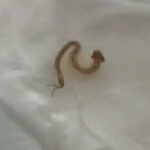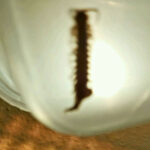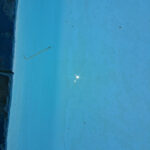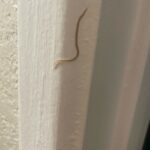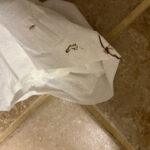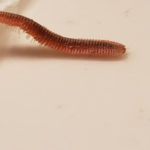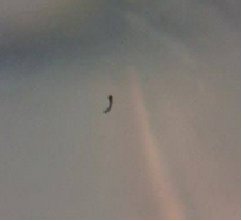
“I found a similar article about white worms in terrariums, but I wanted to be sure I had the same bugs!” exclaims this reader in her submission regarding the translucent worms pictured below. “These white worms don’t appear to be actively moving, and I just noticed them today after having made this terrarium from moss from my yard last month. There’s the white worms, and then another two that appear different. One is browner and looks to have antennae, and the other appears to have legs? I don’t want my other house plants to get infected! This moss was harvested from Pittsburgh, PA.”
Firstly, we want to thank our reader for the excellent photo and bountiful context. It really helps us get a grasp of the creatures we are dealing with quickly and thereby make an identification. Secondly, we are not sure which article our reader refers to, and we do not know if it is one of our own articles or not, so we can unfortunately not use that as reference to see if these are the same organisms. Nonetheless, we will still do our best to identify these organisms and provide whatever advice we can. Additionally, we want to point out that whenever our reader is taking moss (or any other materials from the outdoors) to put inside her terrarium, she will always run the risk of introducing organisms into the terrarium that she might not want there. Based on the fact that she did take this moss from outside, it is apparent to us that this is how the worms got inside her terrarium to begin with; either the worms were already mature and present in the moss, or eggs were, and they hatched inside the terrarium.
We think the “white” worms are soil nematodes. These guys will live in pockets of water present in the soil, and their diet depends on what species we are dealing with. Likewise, the extent to which they could prove harmful to the plants in the terrarium is entirely dependent on their species. There are species of nematodes that are predatory, and will act as a natural control for other organisms that are unfavorable to the ecosystem. There are species that feed on bacteria in the soil, and which can be beneficial to a terrarium as they help balance out the bacteria levels in the soil. Then, there are also nematodes which are parasitic to plants. If these worms were those types of nematodes, we think it would be obvious, as they would be visibly destroying the plant (specifically at the roots).
When it comes to the brown creatures with antennae and the creatures with legs, we think these are both the same creatures, and we think they are centipedes. Centipedes are known for their multiple legs and antennae, and they are commonly brown or yellow in color. They will have gotten into the terrarium the same way that the nematodes did. If the nematodes would become a problem, the centipedes are likely the solution. Centipedes are predatory arthropods (and are not typically worms), and they feed on invertebrates like mites, flies, and, yes, nematodes. So, in this instance, the centipedes would provide a natural control for the nematodes. The only thing is, if the centipedes over hunt the nematodes and run out of food, they would likely die off without any food. But if our reader wants that outcome, then that is not necessarily a bad thing. What our reader will want to do is simply monitor the plant’s health for a while and see if it deteriorates at all as a consequence of these organisms being here. If it doesn’t, then it is likely that the nematodes are not harmful to the plant (and could even be beneficial). If it does start to die, we suggest cleaning out the terrarium as best she can, and replacing the moss with store-bought moss. We should note that the centipedes will not damage the plant.
To conclude, we think that the clear, white worms our reader found in her terrarium are soil nematodes, and that the brown critters with many legs and antennae are centipedes. They might not do any harm to the plants in her terrarium. After all, it is a replica of their natural habitat since they were introduced into the terrarium on the very substance they lived in outside. We hope this makes sense, and we wish our reader the very best!
All About Worms is always free, always reader-supported. Your tips via CashApp, Venmo, or Paypal are appreciated! Receipts will come from ISIPP Publishing.
You might also find these guys interesting!




